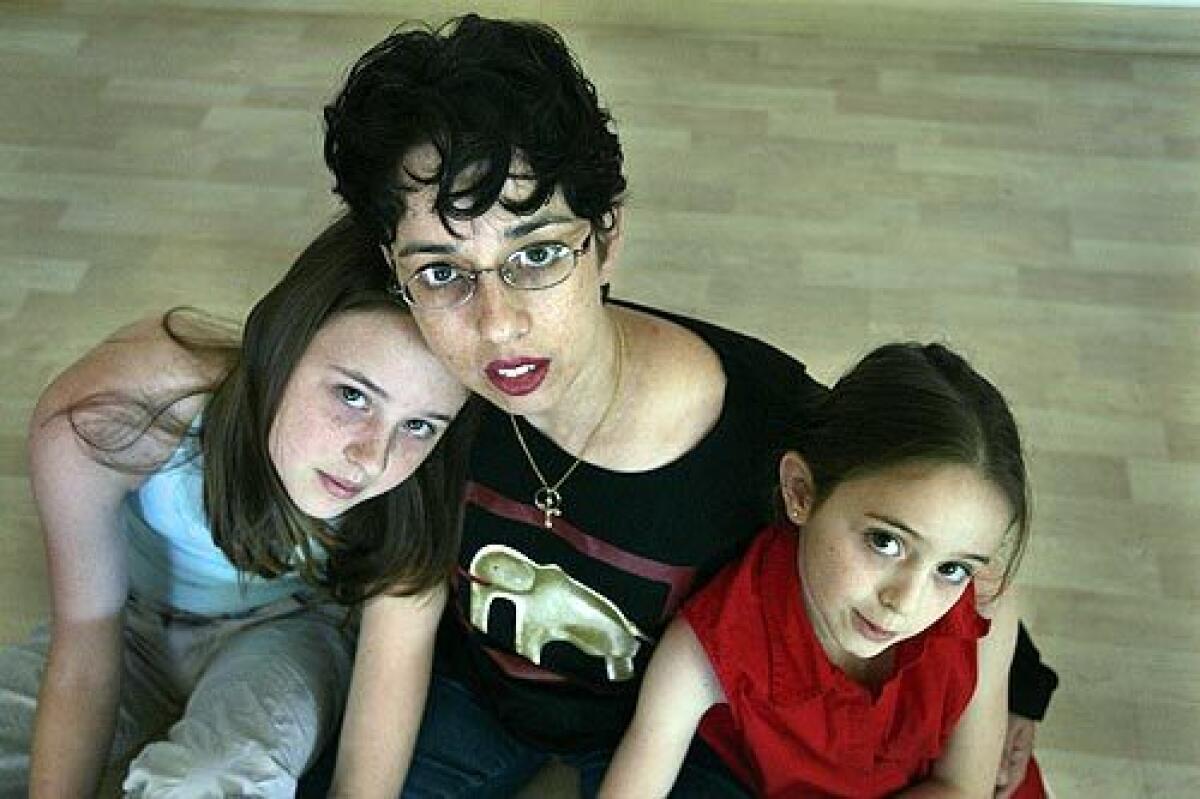A Journey Toward Healing

SAN QUENTIN -- Deep inside this infamous old prison, Patty O’Reilly stands before eight men doing hard time, her shoulders slumped, a man’s gold wedding band hanging from a chain around her neck.
Three of the inmates are sobbing. The others sit motionless on metal chairs, eyes locked on the small, sad woman in front of them.
O’Reilly’s words seep out. A ballet teacher from Sonoma, she has come to San Quentin to share a story -- about the killing of a husband and the trauma caused by that loss.
She tells of two daughters left fatherless, of a widow, not yet 40, paralyzed by grief. Weeping now, O’Reilly describes happy futures shredded in an instant by one man’s single, terrible act.
But she also talks of the unlikely journey that has led her through the gates of San Quentin, to face this group of veteran cons. They can’t believe she’s come. But to hear her tell it, O’Reilly really had no choice.
Her path is being followed by a rising number of crime victims and survivors. Despite ever-tougher sentences and the world’s highest incarceration rate, many victims feel the nation’s traditional method of meting out justice comes up short. Anguished and unable to heal, they are finding strength through an alternative philosophy called restorative justice.
Inspired by ancient tribal traditions and biblical teachings, restorative justice aims to achieve accountability for crimes in a direct, tangible way -- rather than simply through “symbolic” penalties imposed by the state. As supporters see it, offenders must understand that their crimes were not some abstract violation of law, but a harm inflicted upon real people who need a chance to be made whole again.
In perhaps its purest expression, restorative justice occurs through mediated, face-to-face encounters between victim (or surviving relatives) and offender. Victims chronicle their pain, ask nagging questions, speak their piece. Offenders, in turn, confront the extent of the human damage they caused, apologize and agree -- often in a written contract -- to make amends.
Through the process, both sides -- as well as the community damaged by the crime -- theoretically are “restored.”
“The criminal justice system tends to say, ‘OK, we’ve punished the guy, sayonara,’ ” said Todd R. Clear, a professor at John Jay College of Criminal Justice in New York. “But while punishment is important, many victims feel it’s not enough. They need closure. They need to hear why he did it and see some kind of indication that the offender gets it. Restorative justice offers them that.”
O’Reilly’s unwitting acquaintance with the concept began on a rural Sonoma County road one misty April evening in 2004. With one of the family cars sidelined for repairs, her husband, Danny, had offered to bicycle the 30 miles to work that day.
Curly haired and 5 feet 8, the 43-year-old was a doting father with a knack for storytelling and a passion for playing Twister with his daughters, Erin and Siobhan. He remembered everyone’s name, loved Halloween, played the cello and was famous for his homemade soups.
Setting out for home that April day, Danny O’Reilly was well-equipped for the ride -- with flashing safety lights, a bright yellow jacket, a helmet and a headlamp. It wasn’t enough. Rounding a bend on a two-lane road at dusk, he was struck from behind by a pickup truck, his body sent flying 25 feet, over a guardrail and into a patch of weeds. He died instantly.
Late that night, Patty O’Reilly and the girls arrived home to a dark house. After tucking them in, she brushed her teeth and headed for bed, assuming Danny was there. Instead she found no sign of him, and began to fight a creeping sense of dread.
Before long, the sheriff’s deputy had arrived, a priest was on the way and a man who had been driving home from a bar with a blood-alcohol level almost three times the legal limit was under arrest.
In the beginning O’Reilly would simply sit on the floor and cry. For a time, she felt crippled, her walk an awkward shuffle. Sleep was futile, disturbed by visions of Danny’s body and the wheels of a truck.
The garden -- so meticulously tended by her husband -- became overrun with weeds. After friends and family stopped supplying casseroles, O’Reilly hauled the girls to local delicatessens, too shattered to cook. Her 13th wedding anniversary came and went, another agonizing reminder of the loss.
Meanwhile, William Michael Albertson, 47, pleaded guilty to vehicular manslaughter and driving under the influence. With a former felony conviction on his record, he was sentenced to 14 years in prison. Case closed.
For a time, O’Reilly hated the man who killed her husband. She wanted the cell door slammed and never reopened. She wanted him to spend every waking moment agonizing over what he had done.
“I hated him,” O’Reilly recalled. “I really thought he was the scum of the earth. Worse than scum.”
Then she saw Albertson at the sentencing hearing. Clearly distraught, he wept throughout. At the end, he stood, apologized and said he hoped that someday he might be forgiven.
O’Reilly read the report on Albertson’s background, prepared for the court. His childhood, she learned, was full of unspeakable abuse. It was easy to see why he might become an alcoholic, she said, to escape a past filled with so much pain.
Finally, she thought about the anger riding around inside of her, day in and day out. She worried that it might corrode her relationship with her young daughters, struggling themselves to find their footing, to make a new life without a father.
She also remembered her faith. “I had to let go of all that negativity,” she said. “I happen to be a Catholic, but whether you’re Christian or Jewish or Muslim, it comes down to the same thing, love and forgiveness.”
“It’s not excusing -- he did this thing and he needs to suffer the consequences, because we sure as heck are suffering the consequences. But at some point I just had to acknowledge that he is not a monster.” And so, in her heart, Patty O’Reilly forgave William Albertson. She would have left it at that. But another stage in her journey was yet to come.
Bruised and Dazed
Crime victims and survivors have achieved remarkable things over the last three decades. Their rights are now recognized under the law. Victims may make a statement in court at sentencing. Many states, including California, grant them privileges at parole hearings, such as the chance to protest an inmate’s release from afar, by videotape.
But true services for victims -- counseling and restitution, for instance -- are stretched thin. And many say they feel bruised, dazed and, on the whole, dissatisfied once the judges, juries and prosecutors have disposed of their cases.
For some, restorative justice is an appealing answer.
While its theoretical roots stretch back centuries, the modern movement’s birth is typically traced to Ontario, Canada, in 1974. Four years later, the first formal reconciliation work was underway in this country.
Since then, hundreds of programs -- some run by government, some by nonprofit groups or religious organizations -- have sprouted. Most focus on juvenile cases and largely involve nonviolent crimes. Mediation can occur either as a substitute for prosecution, or post-sentencing. It is voluntary and requires both parties’ consent.
Recently, a growing number of states have begun offering restorative justice to victims of crimes by adults. California has small programs at two adult prisons -- San Quentin and Solano State Prison in Vacaville -- but no immediate plans to expand.
Some critics say reconciliation amounts to coddling criminals, believing it might allow them to shorten their prison terms. In fact, parole boards may look favorably upon a convict’s participation, but there is no formal benefit beyond that.
Other victims, especially those who have suffered through violent crime, say the idea of coming face to face with the perpetrator is abhorrent. Their preference is a long prison term and a quickly fading memory of a life-altering event.
But a growing body of research shows that participants in the mediated encounters -- victims as well as offenders -- report strong satisfaction with the outcome. Studies also conclude that lawbreakers who complete the process are less likely to offend again.
“Some people mistakenly think restorative justice is some liberal way of letting offenders get off easy, but it really demands much greater accountability,” said Mark Umbreit, director of the University of Minnesota’s Center for Restorative Justice & Peacemaking.
“I’m not saying it’s some magic bullet. But there’s some pretty good data showing it does at least as much good as the costly, dysfunctional approach we’re using now.”
A Daughter’s Request
You never know how a child will handle the death of a parent.
One day, Siobhan O’Reilly sat down and made a card for the man who killed her father. She drew a picture of her face, with tears streaming. She wrote: My name is Siobhan. I am 8 years old. I’m not mad at you.
Along with writing to Albertson, the little girl made a request: I want to meet him.
Her mother was taken aback. What did it mean? She has a theory.
For his daughters, Danny O’Reilly’s death in some ways was an intangible thing. They weren’t allowed to see his body; they never saw his battered bike. They did not attend the court hearings. In a sense, the only living proof of their father’s fate is locked in a cell at the California Medical Facility, a state prison in Vacaville.
O’Reilly is a mother who takes her children’s comments to heart. Arranging a meeting -- even if it were possible -- might not be wise, she figured. Still, “I didn’t want to ignore it,” she said.
Soon O’Reilly was learning about restorative justice and a woman named Rochelle Edwards. A trained mediator, Edwards was just beginning a program at San Quentin, bringing in surrogate victims to meet with inmates studying the impact of their crimes.
Edwards suggested O’Reilly give it a try. Down the road, if it felt OK, Edwards said they might take another step -- toward a meeting with Albertson.
O’Reilly agreed. Perhaps, she thought, this was a way to do something positive with her husband’s death -- and acknowledge her daughter’s questions.
“When I went to San Quentin,” she said, “I really didn’t know what to expect. I knew my assignment: to tell my story. But I was totally unprepared for what happened.”
The eight men in prison blues thought they were ready. After 15 weeks in class with Edwards, they had covered a lot of ground. They had written essays about shame and guilt. They had mapped out how many victims their acts had truly claimed -- not just the person they harmed, but that person’s children and parents and siblings and colleagues, and on and on.
But none of the men knew how deeply they’d be touched by O’Reilly’s words. Patrick Mims, 43, cradled his head in his hands as O’Reilly -- her voice just above a whisper -- recounted the empty house, her sense of dread, her wailing when the deputy broke the news.
“I just think of her daughters, without a father, and I think of what a deep, loving relationship they had,” said Mims, who has two children of his own. “It’s right there in your face.... It’s devastating.”
Mims represents the other side of the restorative justice equation. Convicted of second-degree murder in 1989, he is serving 15 years to life, with the possibility of parole.
His crime capped years as a user and seller of crack cocaine, a life that began when he ran away from his Berkeley home at age 13. One night in San Diego, trying to buy dope with a buddy, he wound up in a fight, stabbed a man named Kevin Anderson and fled. Four days later, Mims learned that Anderson had died. He turned himself in.
In prison, he has become a certified electrician and plumber and obtained his associate of arts degree. Narcotics Anonymous and Alcoholics Anonymous have been a constant in his life. The parole board tells him he’s on the right track.
After spending long hours in the restorative justice class, Mims wrote a letter to his victim’s parents, apologizing for taking their son from them. He sent it to the San Diego County district attorney last January, hoping it might be forwarded. He has not received a response.
But the most wrenching moment was the visit from O’Reilly, who joined two other victims for a four-hour encounter in a small, stuffy room overlooking the prison’s exercise yard. The victims spoke. Then the inmates -- one by one -- shared the violent, intimate details of their crimes.
One of the convicts then added this: I am truly amazed and humbled, he told the victims, that after all your pain you have come here to talk to people like us.
Tears fell on the prison’s concrete floor. For a while afterward, there was only breathing. Nobody said a word.
Thinking Ahead
A pair of men’s tennis shoes sit by the front door of the O’Reillys’ small Sonoma home. The man who wore them is gone, but his wife can’t bear to move them just yet. The same goes for his clothes in the closet they once shared, and his two spare bicycles, hanging in the garage.
At a wedding, Patty O’Reilly watched the beaming bride dance with her father and realized her girls won’t have that chance.
But some parts of life are growing brighter. Friends replanted the family garden, and O’Reilly now enjoys snipping dead blooms off the marigolds. Her daughters predict the pumpkin plant will yield a big crop by Halloween.
O’Reilly also is thinking ahead, imagining a drive through rolling hills to the prison in Vacaville where William Albertson sits and waits.
She has decided. Sometime next year, she will meet with the man who took her husband from this world.
More to Read
Start your day right
Sign up for Essential California for news, features and recommendations from the L.A. Times and beyond in your inbox six days a week.
You may occasionally receive promotional content from the Los Angeles Times.






